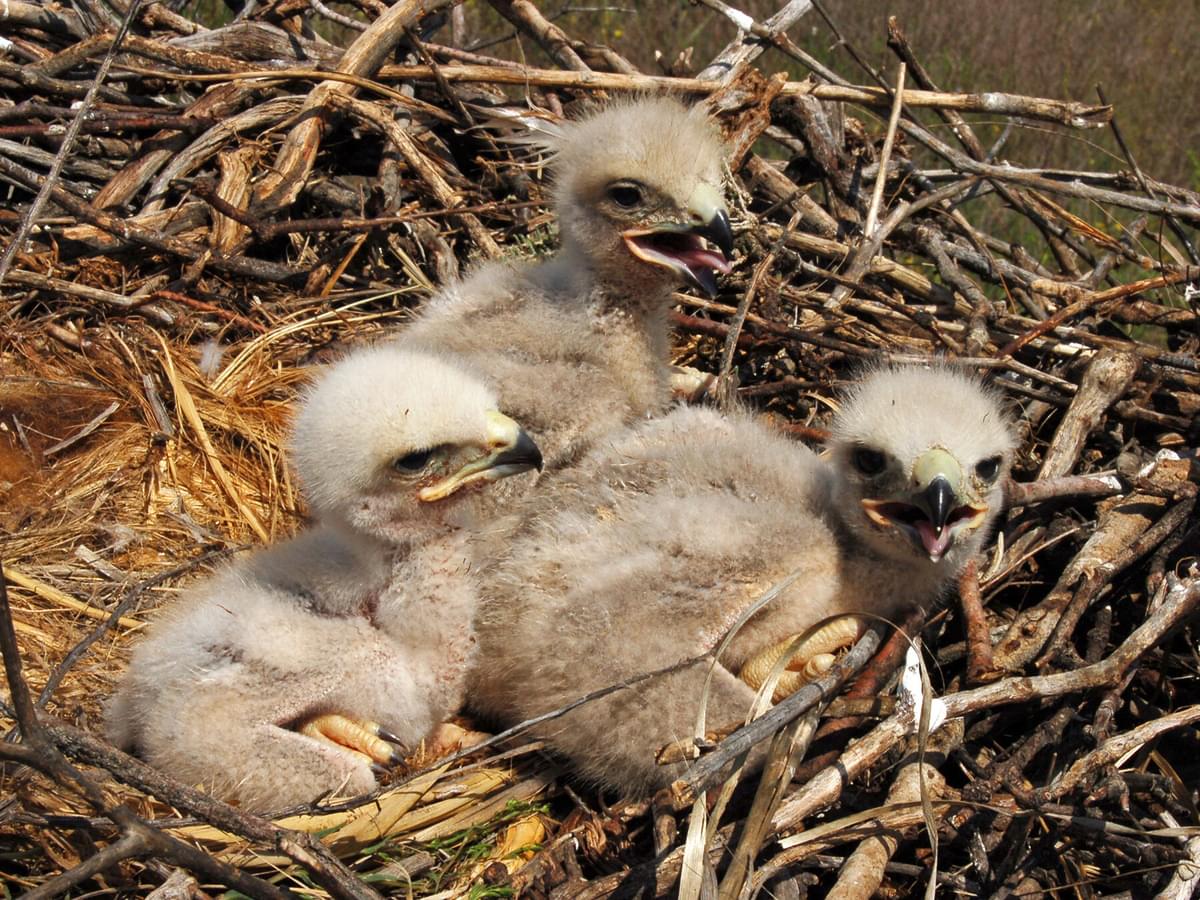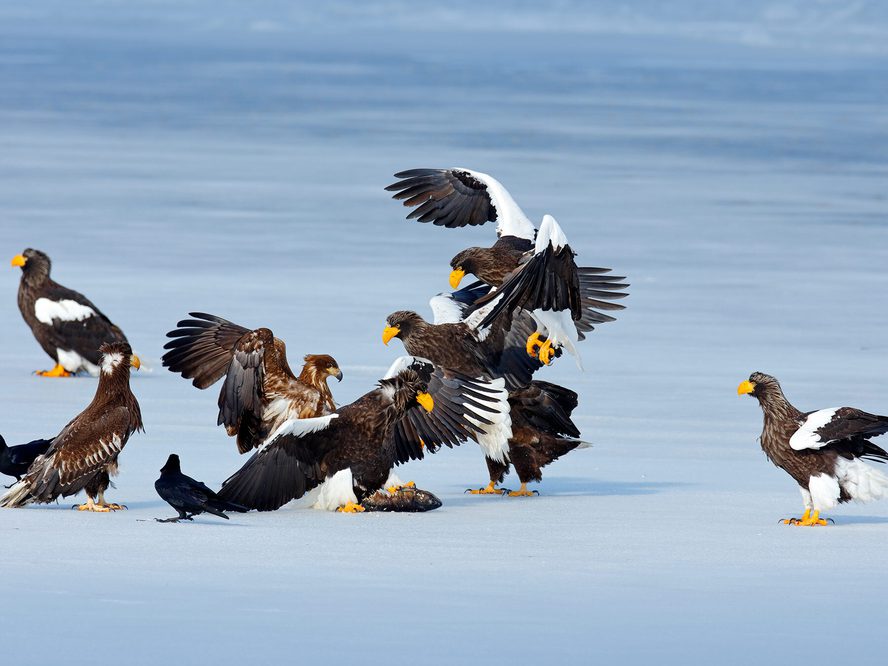Jump to Section
Baby Eagles: All You Need To Know (with Pictures)
Last updated: 8 February 2022

Eagles are probably the most famous and well-known of all the birds of prey. There are some 60 species of eagles distributed throughout the world, primarily in the Americas and Asia, and many are important cultural icons and symbols.
Every mighty eagle starts life as a tiny eaglet - a baby eagle. This article will explore everything about baby eagles, and of course, there will be plenty of pictures of baby eagles along the way!
What does a baby eagle look like?
The vast majority of baby eagles have thick fluffy brown, grey or white down. Probably the only way you’d identify them as an eaglet is by their hooked typically-eagle-like beaks. Otherwise, they look similar to many species of baby birds - fluffy, small and somewhat prehistoric or dinosaur-like!
Baby eagles also have quite a pronounced egg tooth, which is a specialised tip on the front of the beak used to pierce the eggshell. The egg tooth only lasts for around a week after hatching.

A baby bald eagle with their parent in the nest
How big is a baby eagle?
Considering the size of many fully grown eagles, baby eagles are tiny. Even the largest eagles in the world, such as the colossal Harpy Eagle, have eaglets that are just a few inches in length at birth.
Bald Eagle chicks generally tend to measure around 10 to 13cm after hatching (4 to 5 in).
How much do baby eagles weigh?
Even the eaglets of the largest species of eagles weigh just around 100 grams (3.5 oz).
Golden Eagle chicks have been found to weigh around 105 to 115 g (3.7 to 4.1 oz). This is around 3 times the weight of a baby chicken and double that of a duckling. Baby eagles are still small and light for birds of their adult size.

Golden Eagle taking care of its young chick (eaglet)
What do juvenile eagles look like?
Juvenile eagles reach full adulthood slowly, despite reaching a significant size in just 2 months or so. Full adult plumage can take as long as 4 years to develop, at which stage the juvenile eagle will have long reached adult size and will have established its own independent territories.
Many juvenile eagles remain somewhat brown or grey-ish in tone with mottled plumage and tufts of down until they’re 1 year of age at least. Some species, such as the Golden eagle, retain patches of white feathers on their undersides which are lost by full adulthood.
For some species, such as the White-Tailed eagle, adult plumage might take as long as 8 years to develop! This is quite unique amongst the development timelines of other birds.

Juvenile Golden Eagle soaring high in the sky
What is a baby eagle called?
Baby eagles are invariably called eaglets, regardless of the species. At the point a baby eagle fledges the nest, it becomes a fledgling, the same as any other fledgling bird.
What is a group of baby eagles called?
There’s no specific name for a group of baby eagles, but a group of eagles is often called an aerie, soar or convocation.
What do baby eagles eat?
Baby eagles are fed raw meat from day 1. Their parents don’t regurgitate food, but simply tear it up into smaller pieces and feed it to the chicks whole. In the early days, it’s mostly the father that hunts and feeds the chicks, but the mother will likely join after a week or so has passed or if food is scarce.

A Bald Eagle feeding their young with meat
How do eagles feed their chicks?
The adult eagles will hunt food, tear it up, and use their beaks to feed it directly to their chicks. There’s no regurgitation process like there is with other birds - the chicks swallow pieces of meat whole. Eaglets are generally fed around 1 to 8 times a day, the larger chick often gets priority over the smaller one and will therefore be much more likely to survive through to adulthood.
How long do baby eagles take to grow?
Baby eagles grow quickly. By the time they’re ready to fledge after 10 to 14 weeks, many will have reached skeletal maturity already. Some species take longer to reach adult size and weight, but still only around 4 to 6 months at the most.
Juvenile eagles continue to develop muscle mass for a year or longer and for some species like the White-Tailed eagle, full plumage can take up to 8 years to develop!

A young golden eagle chick being looked after by mother
How many eagle chicks survive through to adulthood?
Most species of eagles lay just 2 eggs up to a typical maximum of 4. It’s generally unlikely that more than 50% will survive, and usually, it’s the first-born eaglets that live.
This is because they’re fed sooner and tend to be larger. If food is particularly abundant, it is possible for a pair of eagles to successfully rear 3 chicks, but this is still rare.
What do eagle eggs look like?
Eagle eggs are usually white, sometimes with a pale pink hue, and often have light brown splotches.
They’re generally unremarkable, but the eggs of larger eagle species can reach sizes of 7 to 7.6 cm (2.7 to 3”). This is somewhat similar in girth to a baseball or tennis ball. Compared to the relatively small size of eaglets, eagle eggs are quite large.

Two eagle eggs in the nest
How long do eagle eggs take to hatch?
This does vary from species to species, but generally, eagle eggs take around 35 days to hatch.
Golden eagle eggs take slightly longer, up to 45 days. Harpy eagle eggs are incubated for a whopping 55 days or so before they hatch. This is above average amongst birds, though it doesn’t compare to, say, a Wandering Albatross, who incubate their eggs for up to 85 days!
When do eagles lay eggs?
This varies from species to species and region to region. For example, at northerly latitudes including the UK, North Europe, Canada and the northerly states of the USA, egg-laying typically starts around March and April. Closer to the equator, egg-laying might occur throughout the early winter, as early as November in some regions.
Some eagles such as the Crowned Eagle lay eggs all year round, though there are still peak seasons. Close to the equator, egg laying can often occur at any time of year.

Close up of a Crowned Eagle
How often do eagles lay eggs?
Whilst most eagles lay small clutches of eggs each year, many species of eagles have longer breeding cycles. Some species, like the Harpy Eagle, only lay eggs every 3 to 5 years. Crowned Eagles are similar, laying eggs once every 2 to 3 years.
When can baby eagles fly?
Baby eagles fledge after around 10 to 14 weeks. Their parents will encourage them to fly and leave the nest, but they won’t become more independent for around 2 to 3 months at least, or much longer for some species.
For example, Crowned Eagle and Harpy Eagle eaglets stay with their parents for up to 9 to 10 months, hence why their reproductive cycle is so long.

An immature Bald Eagle in flight
When do baby eagles leave their nests?
It depends on the species of eagle, but most eaglets fledge within 14 weeks or so. However, that doesn’t mean that they truly leave the nest. Whilst baby eagles are somewhat independent of their parents in as little as 3 to 4 months, many stay with their parents until the following winter or next year's spring if they’re born late in the season.
How long do baby eagles stay with their parents?
This really varies between species. For example, the White-Tailed eagle is quick to fledge, typically learning to fly after just six weeks. But then, the juvenile eagle may not leave its family territory for as long as three years.
The Crowned Eagle has an exceptionally long breeding cycle as the eaglets are known to spend at least ten months with their parents, again not leaving the family territory for some time after.
Despite many species of eagles staying with their parents for a while, the eaglets or juvenile eagles themselves are capable of hunting after around 16 weeks, not long after they fledge.

Juvenile White-tailed Eagle
How do baby eagles learn to hunt?
Like many other raptors, baby eagles have innate hunting skills that develop quickly. Whilst they do watch and learn from their parents, most species of eagles can hunt not long after they fledge the nest.
Eaglets will tear and eat their own food after just 3 to 4 weeks - the parents will simply dump the kill in the nest and let them get on with it.
Do eagles reuse nests?
Eagle nests are large, dense and are often intensively built over as long as six months. In emergency situations, eagles can rebuild their nests in a matter of weeks, but it’s definitely preferable for them to have a large, strong and stable nest that they can work to maintain through the year.
Eagle pairs spend a good deal of time locating an ideal nesting site - they are not opportunistic nesters. Once they establish a nest, most species of eagles will maintain it religiously, constantly replenishing it with new material. Some eagle nests can reach enormous diameters of some 3m (9ft) and can be 3 to 5m deep.
On this page
- What does a baby eagle look like?
- How big is a baby eagle?
- How much do baby eagles weigh?
- What do juvenile eagles look like?
- What is a baby eagle called?
- What is a group of baby eagles called?
- What do baby eagles eat?
- How do eagles feed their chicks?
- How long do baby eagles take to grow?
- How many eagle chicks survive through to adulthood?
- What do eagle eggs look like?
- How long do eagle eggs take to hatch?
- When do eagles lay eggs?
- How often do eagles lay eggs?
- When can baby eagles fly?
- When do baby eagles leave their nests?
- How long do baby eagles stay with their parents?
- How do baby eagles learn to hunt?
- Do eagles reuse nests?






